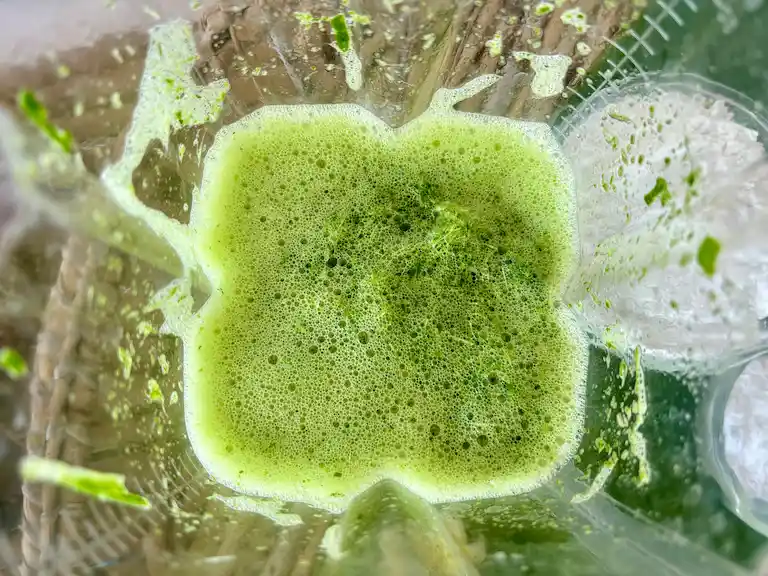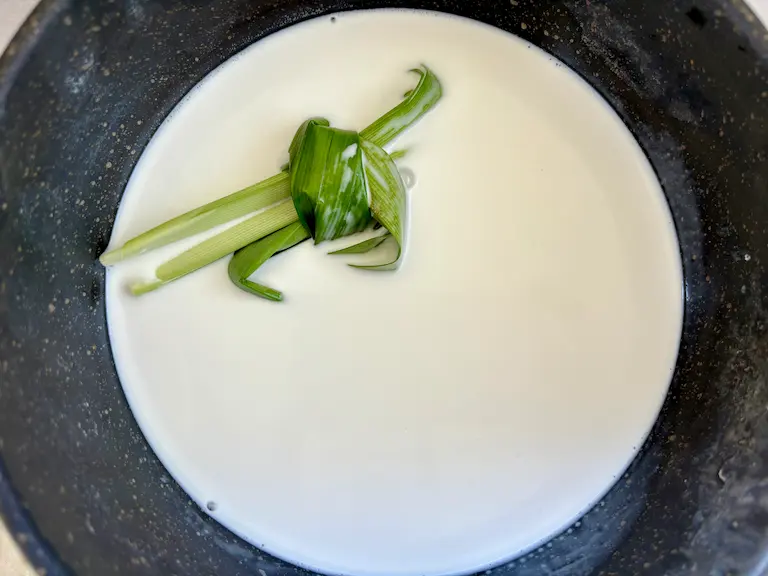Thai lod chong dessert is a wonderful mix of creamy coconut milk, sweet sugar syrup, and homemade pandan noodles. In this delicious cendol recipe, we’re not just making a traditional dessert – we’re turning it into a family-friendly drink too. Perfect for everyone, including the kids!

Lod chong is one of the best Thai desserts for summer, just like ruam mit, tub tim krob, and pandan coconut jelly. A warm day spent at the food market with one of these is my idea of a good time!
This week, I tried making lod chong at home, and I can confirm it’s twice the fun and even more delicious. Before we start making it, here’s a quick rundown of what it is and the process of making it.
What is cendol
Cendol is a Southeast Asian dessert popular for its green jelly noodles made from rice flour and pandan. It’s served chilled with coconut milk and shaved ice, making it a refreshing treat that doubles as a drink.
The exact origin of cendol is unclear, as some debate its origins in Indonesia while others claim it originated in Malaysia.
I don’t mind where it originated, I’m just happy Thailand has its own version! In Thailand, we call it lod chong, in Indonesia it’s called cendol, and in Vietnam it’s known as che banh lot.
Thai Lod chong
Making Thai dessert recipes is always super fun, especially with kids around. This is one of those unique pandan desserts you can turn into an amusing afternoon family activity.
I’ve made sure this recipe is easy to follow for everyone, even those who are new to Thai cuisine. As always, you can simply use the step-by-step images to guide you.

The first step for making pandan noodles is extracting pandan juice, which is easy when using a blender. Next, we’ll mix rice flour and tapioca starch with the pandan juice to create a fragrant green dough.
After preparing the dough, we’ll cook it until it reaches a somewhat slimy texture. Once cooked, this green mixture is transformed into noodles.
Traditionally, a lod chong press is used to shape the pandan dough into noodles. However, if you don’t have one, there’s no need to worry! I’ve found a simple method that you can use instead. You can find this alternative after the instructions section, so make sure to read on.

Once your noodle strands are ready, it’s as good as done. What’s left is to simply mix them with salted coconut milk, prepared sugar syrup, and crushed ice for a bowl full of creamy and sweet goodness!
Cendol drink
The best thing about this dessert is how we can easily turn it into a refreshing drink.
Lod chong drink, or cendol drink, is extremely popular in Southeast Asia. It’s perfect for kids, and you can make it your own creation by topping it with jackfruit, beans, and even tapioca pearls – just like bubble tea!

Simply add the pandan noodles to a chilled glass, pour in some of that delicious coconut milk and sweet sugar syrup, and top if off with crushed ice.
That’s all! It’s great for family gatherings, especially on warm summer days, and you can even make it in advance.
Ingredients
Ingredients can be sourced at Asian grocery stores and Asian markets.
The exact measurements are in the recipe card at the end of this post.

Pandan noodles
- Rice flour – Rice flour is the base of the noodles, giving them a smooth texture.
- Tapioca starch – Tapioca starch makes the noodles slightly chewy.
- Pandan leaves – Gives the noodles their pandan aroma and a green hue.
- Lime water – Helps the noodles become firm. Limewater, made by mixing calcium hydroxide (slaked lime) with water, is used in cooking to help rice flour stick together
Salted coconut milk
- Coconut milk – Use full-fat coconut milk for a creamy and rich coconut dessert
- Salt – Enhances the flavors of the milk.
- Pandan leaves
sugar syrup
- Coconut sugar – Coconut sugar is a popular sweetener in Thai desserts, adding a unique sweetness distinct from white and brown sugar. If you don’t have this, you can use palm sugar.
- Water – For making sugar syrup.
Cooking instructions
Pandan noodles

Step 1: Make limewater by stirring calcium hydroxide into water until it dissolves. Let it sit for 3 hours.

Step 2: Pour off 5 cups of the clear limewater, leaving the sediment. Blend 4 cups with chopped pandan leaves. Save 1 cup for later.

Step 3: Strain the pandan leaf mix into a bowl using cheesecloth.

Step 4: Mix tapioca starch and rice flour in a big bowl.

Step 5: While kneading, slowly add some of the pandan water from step 3 to the flour mix to make a dough.

Step 6: Add the rest of the pandan water to the dough.

Step 7: Transfer the pandan water to a cooking pot and place it over the lowest heat possible, stirring continuously.

Step 8: After about 10 minutes on the heat, the mixture will thicken and begin to clump together. Now, slowly add the cup of limewater you set aside earlier, a little every 3 minutes, and keep stirring without stopping. After 30 minutes of continuous stirring, you’ll see the mixture turn a bright green color and become gooey.

Step 9: Put the dough through a lod chong press into ice-cold water.
Sugar syrup

Step 10: Now, we’ll make the sugar syrup. Place a saucepan over low-medium heat and add water and coconut sugar. Let this simmer for 3–5 minutes until it thickens slightly.
Salted coconut milk

Step 11: We will now make the coconut milk mixture. In a saucepan over low heat, add coconut milk, salt, and pandan leaves. Allow the coconut milk to cook for about 3 minutes.
Serve

Step 12: Drain the noodles. In a bowl, add ice, then noodles, coconut milk, and syrup to taste. Top with jackfruit, corn, or other toppings if you like. Enjoy!
Kitchenware
- Lod chong press, potato ricer, or plastic bag to create the noodles
- Blender for blending pandan leaves into a green colored juice
- Saucepan for making sugar syrup and salted coconut milk
- Pot with tool for stirring for cooking the noodle mixture
- Cheesecloth or fine mesh strainer for pandan juice
- Measuring spoons and cups
- Large bowls
Lod chong press alternative
Plastic bag method: If you don’t have a lod chong press, simply place the cooked pandan dough in a plastic bag, snip off a small corner, and squeeze out the pandan noodles.

Lod chong recipe tips
Serve chilled: Thai lod chong is best served chilled. It’s perfect for making ahead of time and keeping it in the refrigerator for later.
Sweetness: Feel free to adjust the palm sugar syrup to your taste. You can easily turn this into a less or more sweet dessert.
Pandan: If you can’t find fresh pandan leaves, you can use pandan extract as a substitute. A few drops are typically enough.
Presentation tips
You can serve this dessert in a bowl or present it in a tall glass as a lod chong drink. Don’t forget crushed ice and top with your favorite toppings like sweet corn, jackfruit, konjac jelly, and sliced fruits.
Storage and make ahead
Store your leftovers in an airtight container in your refrigerator. It’ll keep well for up to 3 days. If possible, store the noodles and coconut milk separately.
Frequently asked questions
What is cendol made of?
Cendol is made of a mixture of rice flour or tapioca flour, coconut milk, and pandan leaf extract, creating a green, jelly-like dessert often served with coconut milk and palm sugar syrup.
Is this recipe gluten-free?
Yes, rice flour and tapioca starch are naturally gluten-free.
How can I make lod chong green without pandan leaves?
Use a few drops of pandan extract instead.
Authentic Thai dessert recipes
Loved reading this lod chong dessert and cendol recipe? Please make my day by dropping a star rating and/or a comment below! Follow me on Facebook, Instagram, and Pinterest.
Thai Lod Chong Dessert (Cendol Recipe)

Ingredients
PANDAN NOODLES
- 1 cup rice flour
- 5 tablespoons tapioca starch
- 3.5 ounces pandan leaves, chopped
- 5 cups water
- 3 tablespoons calcium hydroxide
SALTED COCONUT MILK
- 2 cups coconut milk
- 1 teaspoon salt
- 2 pandan leaves
SUGAR SYRUP
- 1 cup coconut sugar
- 1/2 cup water
Instructions
PANDAN NOODLES
- Make limewater by stirring calcium hydroxide into water until it dissolves. Let it sit for 3 hours.
- Pour off 5 cups of the clear limewater, leaving the sediment. Blend 4 cups with chopped pandan leaves. Save 1 cup for later.
- Strain the pandan leaf mix into a bowl using cheesecloth.
- Mix tapioca starch and rice flour in a big bowl.
- While kneading, slowly add some of the pandan water from step 3 to the flour mix to make a dough.
- Add the rest of the pandan water to the dough.
- Transfer the pandan water to a cooking pot and place it over the lowest heat possible, stirring continuously.
- After about 10 minutes on the heat, the mixture will thicken and begin to clump together. Now, slowly add the cup of limewater you set aside earlier, a little every 3 minutes, and keep stirring without stopping. After 30 minutes of continuous stirring, you’ll see the mixture turn a bright green color and become gooey.
- Put the dough through a lod chong press into ice-cold water.
SUGAR SYRUP
- Now, we’ll make the sugar syrup. Place a saucepan over low-medium heat and add water and coconut sugar. Let this simmer for 3–5 minutes until it thickens slightly.
COCONUT MILK
- We will now make the coconut milk mixture. In a saucepan over low heat, add coconut milk, salt, and pandan leaves. Allow the coconut milk to cook for about 3 minutes.
SERVE
- Drain the noodles. In a bowl, add ice, then noodles, coconut milk, and syrup to taste. Top with jackfruit, corn, or other toppings if you like. Enjoy!
Notes
- Use the nutrition card in this recipe as a guideline.







I like your instructions with pictures and steps. I think i can do it. Thanks
Thanks! Let me know how it turns out!
Thank you for the recipe! Actually, cendol is still called cendol in Malaysia, not che banh lot. Che banh lot is the Vietnamese name 😊
Hey Pip! Thank you so much for reading through the recipe and noticing that!